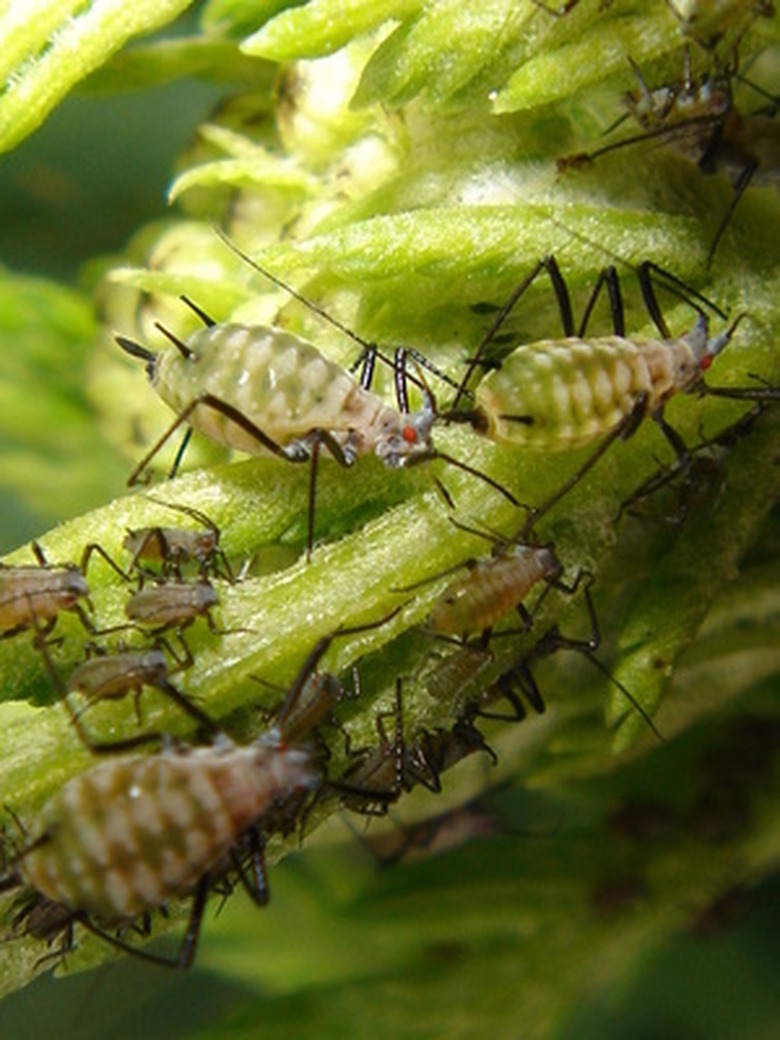Insects That Attack Citrus Trees
Citrus trees, with their fragrant blossoms, ease of growth and attractive leaves, are popular with home gardeners in warm climates. They can be grown in containers or in the ground, and offer a bounty of nutritious and tasty fruit. Citrus trees, with all their positives, can be susceptible to a number of insect pests, most of which can be controlled or eradicated.
Aphids
Aphids suck the juice from citrus trees' leaves. Small numbers of aphids do little or no damage and may even go unnoticed. Large infestations can cause the leaves to pucker, twist, turn yellow, wilt or even drop. Once the leaves drop, the twigs will begin to die from the tips inward. Aphids secrete a sticky substance called honeydew, which often attracts ants. If you see ants swarming on a citrus tree, check the undersides of the leaves. Aphids can be killed with an application of insecticide. More than one application may be needed, so monitor the citrus tree carefully if signs of aphids resurface.
- Citrus trees, with their fragrant blossoms, ease of growth and attractive leaves, are popular with home gardeners in warm climates.
- More than one application may be needed, so monitor the citrus tree carefully if signs of aphids resurface.
Orangedog Caterpillars
The Orangedog caterpillar (Papilio cresphontes) is the unattractive precursor to the beautiful giant swallowtail butterfly. These caterpillars feast on the juicy leaves of citrus trees, skeletonizing them. A large infestation of caterpillars can defoliate a small tree in a week. The first sign of infestation is chewing marks on the edges of the leaves. Once the marks appear, the caterpillars usually are easily seen with the naked eye, as they are large (up to 2 inches) and dark brown in color. The best way to get rid of the Orangedog caterpillar is to pluck it off the tree by hand. This can be distasteful, however, as the caterpillar emits a stinky odor when disturbed. Another option is to douse the tree with insecticide. Choose one that is formulated specifically to kill these common citrus tree pests, and reapply according to the instructions on the label.
- The Orangedog caterpillar (Papilio cresphontes) is the unattractive precursor to the beautiful giant swallowtail butterfly.
- The best way to get rid of the Orangedog caterpillar is to pluck it off the tree by hand.
Citrus Whitefly
Citrus whitflies are very tiny, flying insect pests. They usually hide under the leaves of the citrus tree, sucking the juices. When the tree is disturbed, the flies will swarm up and off of the leaves. The larvae of the adults also feed on the leaves, which causes them to curl up. The leaves may also look like they are covered with gray fuzz because the honeydew excreted from whiteflies looks somewhat like gray, sticky mold. Whiteflies and their larvae can be killed by applications of insecticide. Choose one that is made specifically to kill citrus whiteflies for best results.
- Citrus whitflies are very tiny, flying insect pests.
- Whiteflies and their larvae can be killed by applications of insecticide.
Scale
Scale is a common insect pest on citrus and other types of trees. These sucking insects stick their sharp tubes into the tree and stay put, literally sucking the life out of the tree. They can be found on the trunks, stems and branches of citrus trees. Heavy infestations can cause premature leaf and fruit drop. Scales can be hard or soft-shelled and usually need to be sprayed with more than one application of insecticide before they are killed. The most commonly found hard scales are purple scales, which look like hard, small purple bumps on the backs of leaves. Snow scale has the appearance of flakes of snow scattered on the branches. The most common soft scale insects are the Caribbean black scales, which have soft, lumpy black bodies found in clumps at the base of the leaf stems, and the cottony cushion scale, which looks like small bits of fluffy cotton stuck to the branches.
- Scale is a common insect pest on citrus and other types of trees.
- The most common soft scale insects are the Caribbean black scales, which have soft, lumpy black bodies found in clumps at the base of the leaf stems, and the cottony cushion scale, which looks like small bits of fluffy cotton stuck to the branches.
